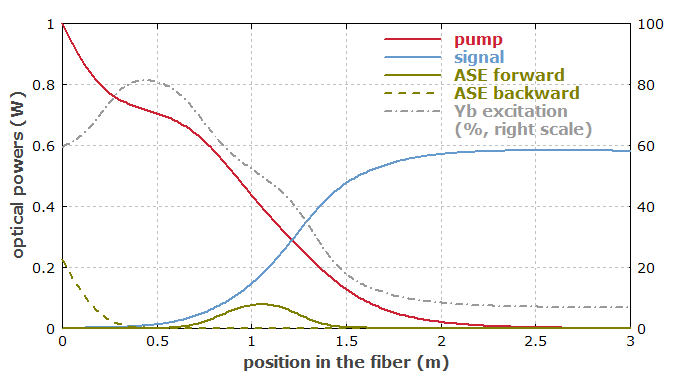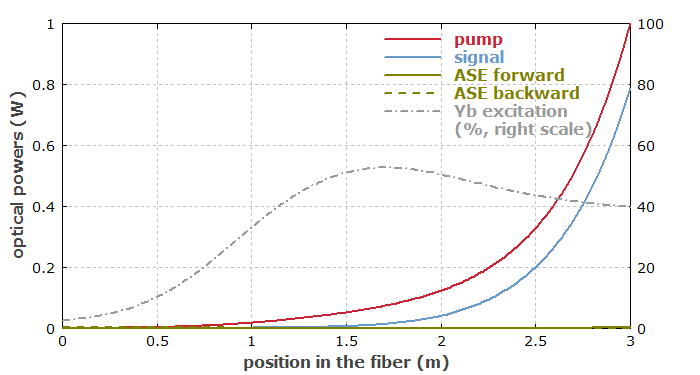Fiber Amplifiers
This is part 5 of a tutorial on fiber amplifiers from Dr. Paschotta. The tutorial has the following parts:
1: Rare earth ions in fibers, 2: Gain and pump absorption, 3: Self-consistent solutions for the steady state, 4: Amplified spontaneous emission, 5: Forward and backward pumping, 6: Double-clad fibers for high-power operation, 7: Fiber amplifiers for nanosecond pulses, 8: Fiber amplifiers for ultrashort pulses, 9: Noise of fiber amplifiers, 10: Multi-stage fiber amplifiers
Part 5: Forward and Backward Pumping
If we amplify some signal in a fiber amplifier, we have different options for pumping:
- Forward pumping means that the pump wave travels in the same direction as the signal wave.
- Backward pumping means that the pump wave travels in the opposite direction.
- One can also pump in both directions simultaneously; this is called bidirectional pumping.
Figure 1 shows a bidirectionally pumped fiber amplifier. Radiation from the left laser diode for forward pumping is combined with the input signal, using a dichroic fiber coupler. After the active (erbium-doped) fiber, there is a second dichroic coupler for injecting light from the second pump diode in backward direction. The same coupler also prevents any residual pump light from getting to the signal output.

In the following, we look at various technical details which partly result in advantages for some pumping direction.
Power Conversion Efficiency
In simple cases, with negligible parasitic losses of the active fiber and with negligible ASE (see part 4), the power conversion efficiency of the amplifier does not depend on the pump direction:
- The overall gain depends only on the average excitation density along the fiber.
- The total pump absorption efficiency also depends only on that average.
- The same holds for the amount of power lost via fluorescence (spontaneous emission).
All this holds also for quasi-three-level laser transitions, and of course also for bidirectional pumping.
If the fiber has substantial parasitic losses, backward pumping is more efficient. This is because the signal is strong near the pump input end, holding the excitation density down in that region, so that the pump light is efficiently absorbed by the ions before parasitic losses can get it. In certain situations, bidirectional pumping may be even more efficient. However, most amplifiers are only a couple of meters long, and parasitic losses within that length are not very important.
A more important difference for the power conversion efficiency can arise from ASE and is discussed next:
Amplified Spontaneous Emission
We have already seen in part 4 that without a signal input, ASE can be much stronger in backward direction. Not surprisingly, that asymmetry does not vanish if we also have a signal input, and the amount of ASE – which constitutes a power loss – can substantially depend on the relative direction of signal and pump light.
As an example, let us consider the same ytterbium-doped fiber amplifier as in part 3 and 4. We have already seen how the powers evolve for forward pumping at 940 nm and 1 mW of signal input power at 1030 nm on the left side:

Now we change to backward pumping:

We see that ASE is now negligibly weak, and we obtain 346 mW of signal output power instead of only 290 mW. The ASE spectrum (not displayed here) only shows some weak ASE around 1030 nm and much less around 975 nm. Positive net gain at 975 nm occurs only in a short region of the fiber around 2 m from the left side.
These findings are quite typical. Generally, quasi-three-level fiber amplifiers have lower ASE losses for backward pumping, and therefore a higher power conversion efficiency in that configuration, if ASE losses would otherwise be significant. For higher input signal powers, causing stronger gain saturation, the difference between the two directions is smaller.
Noise Contamination of the Signal
Another aspect is that ASE which propagates together with the signal constitutes a broadband noise for that signal. For backward pumping, the ASE propagating in the same direction as the signal is generally stronger for quasi-three-level systems – even if the total power loss by ASE is lower! So for low-noise operation, forward pumping is better, despite the possibly lower efficiency.
Nonlinear Effects
If we amplify short pulses, nonlinear effects are often detrimental. This will be discussed in part 7, but here it should be mentioned already that backward pumping is often much better. The reason is that for backward pumping, the pulse energy and peak power initially rises more slowly, so that the spatially integrated peak power gets lower for a given output peak power.
Go to Part 6: High-power Fiber Amplifiers with Double-clad Fibers or back to the start page.
Questions and Comments from Users
Here you can submit questions and comments. As far as they get accepted by the author, they will appear above this paragraph together with the author’s answer. The author will decide on acceptance based on certain criteria. Essentially, the issue must be of sufficiently broad interest.
Please do not enter personal data here; we would otherwise delete it soon. (See also our privacy declaration.) If you wish to receive personal feedback or consultancy from the author, please contact him e.g. via e-mail.
By submitting the information, you give your consent to the potential publication of your inputs on our website according to our rules. (If you later retract your consent, we will delete those inputs.) As your inputs are first reviewed by the author, they may be published with some delay.



These sharing buttons are implemented in a privacy-friendly way!



